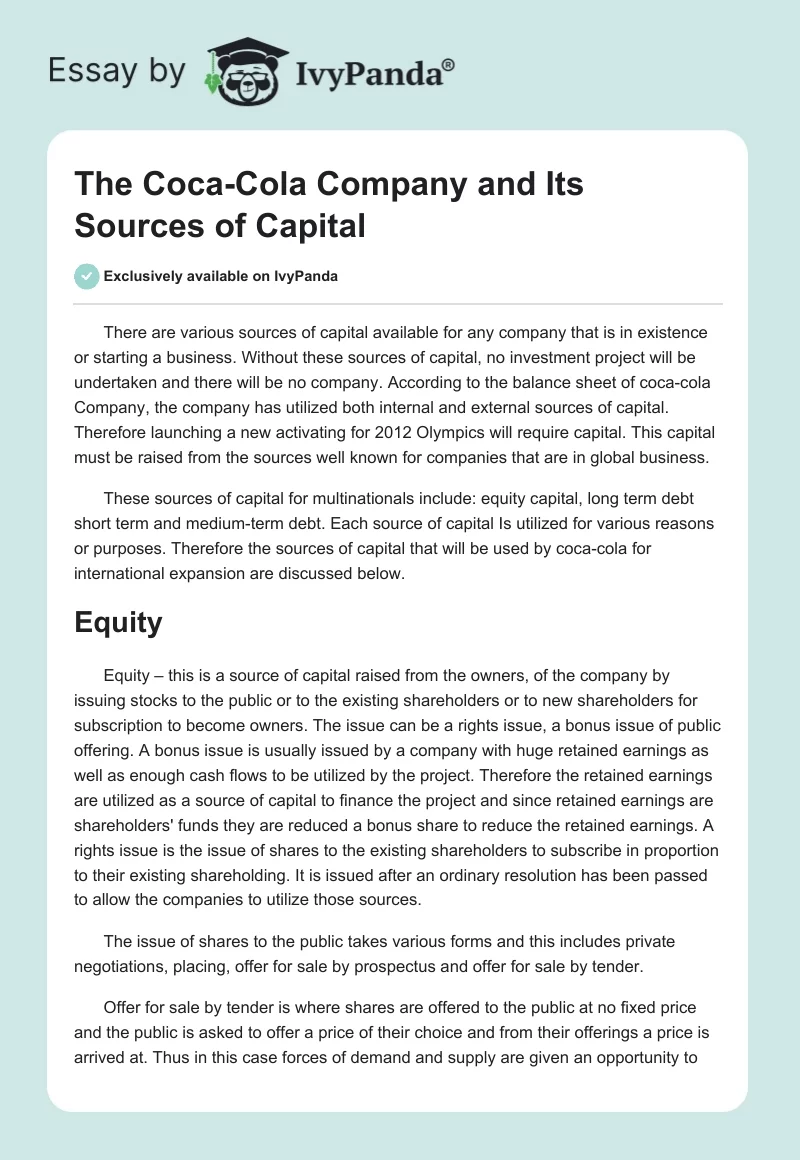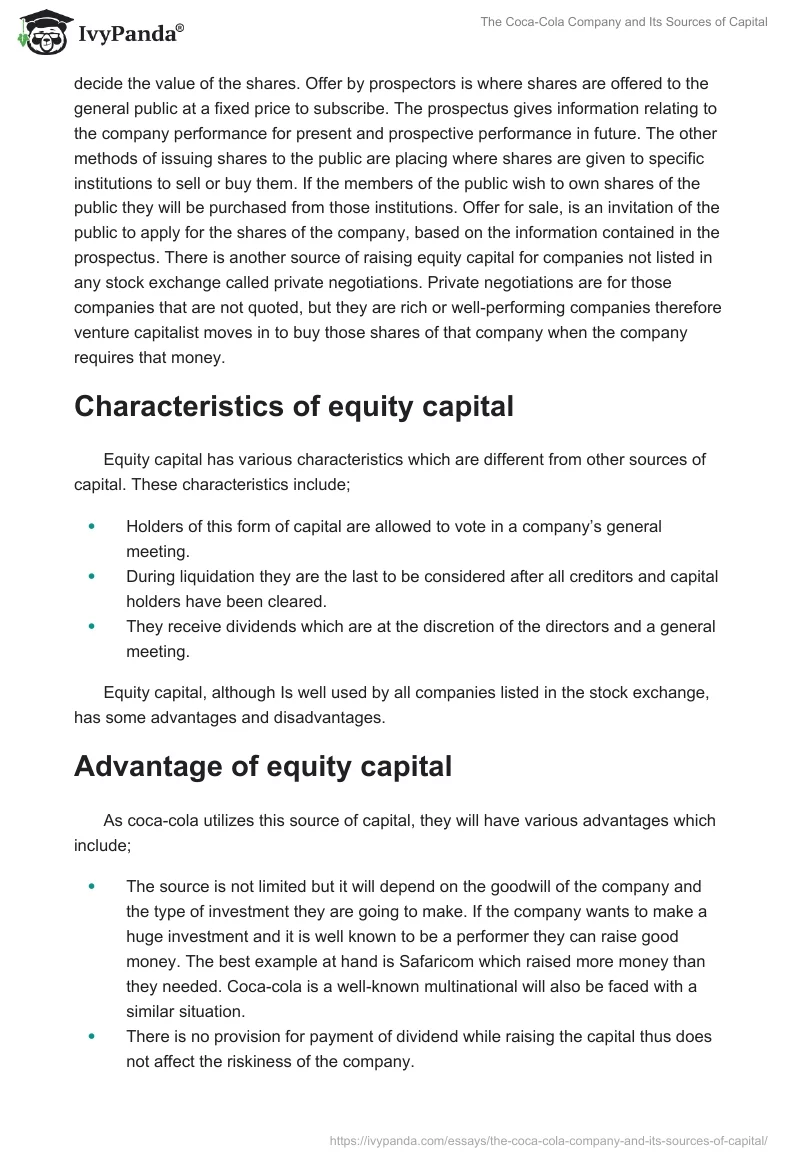There are various sources of capital available for any company that is in existence or starting a business. Without these sources of capital, no investment project will be undertaken and there will be no company. According to the balance sheet of coca-cola Company, the company has utilized both internal and external sources of capital. Therefore launching a new activating for 2012 Olympics will require capital. This capital must be raised from the sources well known for companies that are in global business.
These sources of capital for multinationals include: equity capital, long term debt short term and medium-term debt. Each source of capital Is utilized for various reasons or purposes. Therefore the sources of capital that will be used by coca-cola for international expansion are discussed below.
Equity
Equity – this is a source of capital raised from the owners, of the company by issuing stocks to the public or to the existing shareholders or to new shareholders for subscription to become owners. The issue can be a rights issue, a bonus issue of public offering. A bonus issue is usually issued by a company with huge retained earnings as well as enough cash flows to be utilized by the project. Therefore the retained earnings are utilized as a source of capital to finance the project and since retained earnings are shareholders’ funds they are reduced a bonus share to reduce the retained earnings. A rights issue is the issue of shares to the existing shareholders to subscribe in proportion to their existing shareholding. It is issued after an ordinary resolution has been passed to allow the companies to utilize those sources.
The issue of shares to the public takes various forms and this includes private negotiations, placing, offer for sale by prospectus and offer for sale by tender.
Offer for sale by tender is where shares are offered to the public at no fixed price and the public is asked to offer a price of their choice and from their offerings a price is arrived at. Thus in this case forces of demand and supply are given an opportunity to decide the value of the shares. Offer by prospectors is where shares are offered to the general public at a fixed price to subscribe. The prospectus gives information relating to the company performance for present and prospective performance in future. The other methods of issuing shares to the public are placing where shares are given to specific institutions to sell or buy them. If the members of the public wish to own shares of the public they will be purchased from those institutions. Offer for sale, is an invitation of the public to apply for the shares of the company, based on the information contained in the prospectus. There is another source of raising equity capital for companies not listed in any stock exchange called private negotiations. Private negotiations are for those companies that are not quoted, but they are rich or well-performing companies therefore venture capitalist moves in to buy those shares of that company when the company requires that money.
Characteristics of equity capital
Equity capital has various characteristics which are different from other sources of capital. These characteristics include;
- Holders of this form of capital are allowed to vote in a company’s general meeting.
- During liquidation they are the last to be considered after all creditors and capital holders have been cleared.
- They receive dividends which are at the discretion of the directors and a general meeting.
Equity capital, although Is well used by all companies listed in the stock exchange, has some advantages and disadvantages.
Advantage of equity capital
As coca-cola utilizes this source of capital, they will have various advantages which include;
- The source is not limited but it will depend on the goodwill of the company and the type of investment they are going to make. If the company wants to make a huge investment and it is well known to be a performer they can raise good money. The best example at hand is Safaricom which raised more money than they needed. Coca-cola is a well-known multinational will also be faced with a similar situation.
- There is no provision for payment of dividend while raising the capital thus does not affect the riskiness of the company.
Disadvantages
There are various disadvantages associated with this type of capital. This include
- Once this share has been issued they dilute the control of the company thus the performance may be affected.
- It is an expensive source of capital because there is a cost to advertise for the issuance of shares.
- Not all companies can access this form of capital because others are not listed on the stock exchange.
- It is risky to issue large amounts of these shares because they will increase the rate of return and reduce the earnings per share.
Short term and medium-term financing
Short-term is a form of financing whose period of repayment is up to one year.
Medium-term is a form of financing from one year to seven years. This form of financing is best when the finance raised is to meet a specific current requirement that is not expected to continue indefinitely. Examples of short-term finances are:
Bank – overdrafts
These are usually provided by the clearing banks and presents permission by the bank to write a cheque even though the Company has insufficient funds deposited in the account to meet the cheque’s amount. The company will use this facility up to the limit placed and interest is charged by the bank on amounts outstanding at any one time, and the bank may require repayment of an overdraft at any time.
Bank loans
This is a formal agreement between the bank and the borrower, that the bank will lend a specific sum for a specific period. Interest is charged on the whole amount for the duration of the loan.
Trade credit
This is a form of financing whereby the company can acquire goods or is able to obtain goods or services from suppliers without immediate payment on agreement that the company will pay at a later date. Credit periods vary from one industry to the other. But there are circumstances where longer periods of credit are offered depending on the types of goods or services supplied for instance where goods supplied require a long period to be converted into saleable products for example farming.
Characteristics of short-term financing
- They are risky since they can be paid on demand or within the stated period and normally the duration is short whereas others can be terminated at any period depending on the financial position of the company for example bank overdrafts and loans.
- During winding up of the company, they are given last priority since they are not secured.
- They have no voting rights in the company’s general control.
Advantages
- Flexibility – they can be sued as required for instance bank overdrafts can be sued so long as the company does not exceed the required limit. Also credit period can be extended depending on the goods or services supplied.
- Liable – any company can easily access this facility so long as it meets the requirements.
- Not expensive – interest rates are usually above the base rate and are tax-deductible.
Disadvantages
- Risky since they are legally repayable on demand or within a certain stated period depending on the financial position of the company.
- Security is usually required by way of fixed or floating charges on assets or sometimes in private companies by personal guarantees from owners.
- Interest costs vary with bank base rates.
Long term sources of capital
Long-term is a source of financing whereby funds obtained can be repaid back after a long period of time normally from eight years and above. The company pays interest and principal or dividend at stated or prescribed period. Examples of this are;
Debentures: – Is a written acknowledgment of a debt by a company containing provisions of interest and the terms of repayment of principal. This can be secured or unsecured or irredeemable or redeemable.
Secured debt will carry charge on one or more specific assets or all assets of the company such that on default of repayment of interested principal, the debenture holder will appoint receive to administer the assets until the interest is paid eventually they can sale the asset to repay the principal.
Redeemable debt is where the principal is repayable at a specified future date whereas irredeemable is the opposite.
Preference shares:- Is a form of financing whereby shareholders are paid a fixed rate of dividend after creditors but before ordinary shareholders. This can be
Cumulative preference shares where shareholders are paid a fixed amount of dividends and arrears accumulate; non-cumulative where they receive a fixed rate of dividend but arrears do not accumulate.
Advantages
- Cheap – because is less risky, debenture holders can accept a lower rate of return.
- Cost is limited to the stipulated interest repayment.
- There is no dilution of control where debt is offered since no voting rights.
Disadvantages
- Interest is a compulsory default will mean selling the company securities or the company will go under receivership.
- It is limited since the shareholders are concerned that a geared company can not pay its interest and still pay its dividend and raise the rate of return that they require from the company to compensate for this risk.
- Provision must be made for the repayment of debt with fixed maturity rate.
- If the general interest rates fall, fixed-rate interest payments may prove to be a burden.
Conclusion
Coca-cola will utilize the above sources of capital in raising funds that will be used in the new activities for 2012 Olympics.
References
Altman E.I. (1993) corporate financial distress and bankruptcy, 2nd edition new York John welling and sons.
Beaver W. H (1989) financial reporting: Accounting revolution, Englewood cleves, prentice hall.
Glautier M W E & Underdown D (1977) accounting theory and practice pitman.
Sterling, Robert R, Theory of the measurement of enterprise income. Lawrence, KS: university press of Kansas, (1970).
White G I Sondhi E C & Fried D (1999): The analysis and use of financial statements Wiley.



